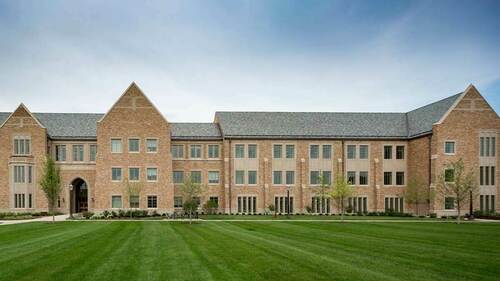
The U.S. Green Building Council has awarded the University of Notre Dame with Leadership in Energy and Environmental Design (LEED) Gold certification for McCourtney Hall, a facility dedicated to research in the molecular sciences and engineering.
The 220,000-square-foot building, which opened in 2016, gives faculty and students space to advance knowledge in areas of science and engineering such as antibiotic resistance, renewable energy and other fields, including drug discovery, analytical sciences and engineering, and chemical and biomolecular engineering.
With the goal of earning LEED Gold certification, the architects implemented sustainable building practices from concept to completion, sourcing 33 percent of the building materials from the local region and using more than 32 percent of materials with recycled content. The University repurposed 5,954 tons of asphalt millings, and diverted 108 tons of paper and cardboard from landfills.
“Earning the distinction of LEED Gold recognizes the University’s commitment to efficient, sustainable design and operation that contributes to the good stewardship of our natural resources,” said Vice President for Facilities Design and Operation and University Architect Doug Marsh. “We continually seek for ways to utilize technology and industry-leading green building methods to create a sustainable built environment that serves our campus community well.”
The daily operation of McCourtney Hall conserves energy and water. Throughout the interior and exterior of the building, LED lighting decreases the amount of electricity used, while occupancy sensors in the interior spaces reduce lighting power density, conserve the amount of airflow and reduce reheat energy. Notably, a heat recovery system moves heat from the exhaust air to the supply air during the winter months, and from the supply air to the exhaust air in the summer months, which reduces the consumption of chilled water and steam. Similarly, a heat recovery chiller moves heat from the chilled water return to the heating water supply, which also reduces the consumption of chilled water and steam. With high-efficiency fixtures and sensor metered lavatory faucets, the facility uses 37 percent less water than the standard new facility.
Since 2008, the University of Notre Dame has been committed to following LEED standards for all new construction. Including McCourtney Hall, the University has earned nine LEED Gold certifications and three LEED Silver certifications, and is in the process of seeking three additional LEED Silver certifications. Other LEED Gold-certified buildings include Flaherty Hall, Dunne Hall, Stinson-Remick Hall, the Purcell Pavilion, Geddes Hall, Ryan Hall, the renovation of the Morris Inn, and Carole Sandner Hall. In addition to saving energy and resources, the new buildings will contribute to a greener, more sustainable environment for generations to come.
Contact: Doug Marsh, associate vice president and University architect, dmarsh@nd.edu